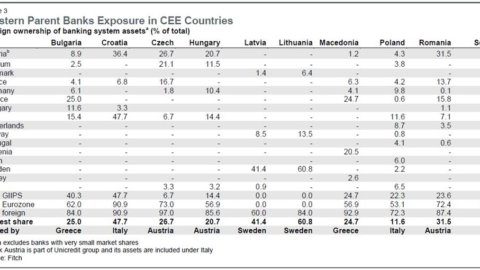As pointed out in the focus of the Intesa Sanpaolo Study Centre, the rapid fall in loans continues (-3,9% in 2012, -4% in February) by the Croatian credit system, due to the continuation of the economic and financial crisis. Real GDP also fell last year (-2%), continuing a decline that has continued since 2009. In this context, the weight of both loans and GDP has decreased, with the private sector loans to GDP ratio falling from 75% to 70%, where loans to businesses are particularly weak, dropped by 8,8% in December, the decline of which continued in the first months of this year (-8,6% in February). And, although in 2012 the overall degree of corporate debt decreased, above all due to the lower external debt, due to the parallel reduction in GDP, the corporate debt/GDP ratio remained at 78%. In the last two months there has been a slight increase in working capital (+2,5% in February compared to December) against a new decline in investments (-0,2% in the same period).
The sectoral breakdown of the Croatian economy shows shares among the individual financed sectors substantially stable over time, with a clear prevalence of the private sector (69% in December 2012, down from 73% in 2010). Banks cover only about 6%, a slight decrease compared to 2009 (7%); on the other hand, the public sector obtained higher percentage resources at the end of 2012 (25%) compared to 2010 (18%). Loans to households, committed to reducing their high level of debt, recorded a slight increase (0,7%) in 2012, followed by a slight drop in February compared to December (-0,2%), where a large part (48,3% of the total) is represented by home loans, down slightly in 2012 (-0,6%) . Furthermore also households remain highly exposed to exchange rate risk, due to the fact that 75% of loans to this sector are in foreign currency or indexed. The credit risk towards the household sector is expected to increase due to the increase in unemployment and the reduction in incomes, combined with high interest rates and high exchange rate risk.
In this scenario, a weakness is represented by provisions and credit losses against the increase in non-performing loans due to adverse economic conditions which brought the non-performing loans/lending ratio to 13,6% at the end of 2012 in the private sector, also due to the decline in loans. In households, bad loans recorded last September amounted to 9,4% of loans, while with regard to businesses, bad loans reached 24,4% at the end of September, above all in the construction and manufacturing sectors, while the degree of coverage is modest, just over 40%.
Despite the difficult economic performance, total deposits show substantial resistance, even strengthening in recent months, with growth rates of 5% in February (from +3,5% in December), thanks to a greater propensity to save of households (with deposits at +7,5% in December, +6,9% in February) pending an improvement in economic conditions especially in the labor market and the shifting of expenses into the future. By contrast, corporate deposits have continued a rapidly downward run since 2011, even if in recent months the contraction has been more modest (-2,9% in February, from -11,1% in December 2012). In a context of economic slowdown and declining loans, bank funding benefited from the growing deposits made by money market investment funds, driven by the low yields of government bonds. Foreign liabilities, which represent approximately 20% of the total, have recorded a significant decline since May 2012, with substantial changes in recent months (-22% in both January and February). This was determined both by the increase in the cost of funding on international markets and above all by the greater propensity of foreign parent companies to finance the activity with domestic resources. As for individual sectors, the exposures of the main international banks still show negative annual rates of change vis-à-vis the banks (-6,1% in December from -15% last June), as well as, but to a lesser extent and catching up, towards the private sector (-5,1% in December from -19,7% last June). On the other hand, there are still positive changes in the public sector (10,4% in December), as in September (+6%), recovering compared to June (-6,4%).
In 2012 the slowdown in the net economic results obtained by the banks continued. According to the Croatian Central Bank, the net result fell in December, bringing ROA and ROE respectively to 1% (1,2% in 2011) and 7,2% (8,7% in 2011). In particular, the interest margin fell by approximately 9% following the increase in the cost of funding and at the same time there was a deterioration in credit quality accompanied by a greater share of lower-yielding assets. The only asset item that led to an increase in positive income components is that relating to local government bonds. A weakness is represented by provisions and credit losses against the increase in non-performing loans due to adverse economic conditions, which brought the non-performing loans/lending ratio to 13,6% at the end of 2012 in the private sector, also due to the decline in loans.
In comparison with some major neighboring countries, Croatia shows a higher degree of capitalisation, supported by good profitability, but subject to higher risks, above all exchange and credit risks due to the modest coverage of non-performing loans, where the risks of financial instability remain mainly due to external events, both macroeconomic and financial. The low coverage of non-performing loans could then affect the degree of capitalization in the event of a further deterioration in the quality of the portfolio. The high exposure of borrowers to exchange rate and interest rate risk remain weaknesses for banks, while the strong dependence of foreign banks on their European parent companies exposes them to the risk of contagion.





